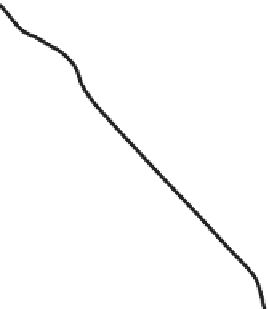Geology Reference
In-Depth Information
76
o
36'W
North
Atlantic
Glass Window
Ocean
BOILING HOLE
25
o
26'N
N
25
25
75
0
1
km
Gregory Town
5 km
Fig. 9.
Topographic map of the Boiling Hole-Glass
Window area. The modern windward shoreline truncates
a NW-SE trending aeolian ridge of Middle Pleistocene age,
indicating that a substantial amount of regressive erosion
occurred since that time (modifi ed from the topographic
map Eleuthera No. 4 published by the Department of Lands
and Surveys, Nassau; contour lines are in feet).
Fig. 8.
Oolitic-peloidal grainstone collected from the
Gregory Town ridge (sample EL 159). Note the greater
abundance of normal ooids and meteoric sparry calcite
cement compared with the younger East End Point oolite.
is extremely narrow (Fig. 7), and does not seem
extensive enough to support an ooid factory, even
of the Joulters Cays type. However, the scalloped
shape of the bank margin, which could be related
to platform collapse (Mullins & Hine, 1989;
Mullins
et al.
, 1991), and the truncation of middle
Pleistocene deposits in the Boiling Hole area, just
north of Gregory Town (Fig. 9), both suggest that
the North Eleuthera bank has experienced a sig-
nifi cant amount of recessive erosion since the late
Pleistocene. Similar bank-margin retreats have
been documented from the Cat Island platform
(Freeman-Lynde & Ryan, 1985) and from Silver,
Navidad and Mouchoir Banks in the SE Bahamas
(Mullins
et al.
, 1992) for older geological periods.
Furthermore, seismic data from the Bahamas/
Blake Escarpment north of Little Bahama Bank
(LBB) indicate about a 5 km retreat since the Early
Cretaceous. It is not clear whether the recess of
these bank margins results from a few major
mass-wasting events or from a constant process
of chipping away. In the former case, large-scale
collapse of platform margins, well away from
a plate boundary, would appear as a recent
(i.e. late Pleistocene), if not an on-going phenom-
enon that could represent serious tsunami hazards
for the low-lying coastal zones in the Caribbean
and southeastern USA (H.T. Mullins, personal
communication). Regardless, part of the large ooid
accumulations exposed on the windward islands
could be derived from shoals that covered an outer
portion of the platform that no longer exists due to
recessive erosion processes (Fig. 7).
Ooid production on the bank side and
exportation to the outer platform
According to a third model, suggested to the fi rst
author by R.N. Ginsburg some years ago, ooids
were formed on the bank side of the islands, trans-
ported eastward by tidal currents to the ocean side,
and then back onto the islands by the trade-wind
action. An illustration of this model can perhaps be
observed near Lee Stocking Island (LSI, Exumas,
Fig. 1). In this area, kilometre-sized ooid shoals
formed by fl ood-tidal delta bars and levees occur
at the bankward end of inter-island channels
(Fig. 10; Kendall
et al.
, 1990; Gonzalez & Eberli,
1997). Indeed, one might expect that ooids could
be carried seaward by ebb currents, deposited on
ocean-facing beaches by waves, and fi nally blown
onto dunes by the prevailing easterly winds.
However, the modern, ocean-facing beaches on LSI
are composed of bioclastic sand probably derived
from offshore reefs. In addition, ebb-tidal deltas
do not occur at the seaward end of the channels
(Fig. 10), indicating that sediments are either swept
off to deeper depositional environments (Dill
et al.
, 1989) or confi ned to the tidal channel
by a circular hydrodynamic pattern (Reeder &
Rankey, 2005).
Trade winds further provide a persistent set-up
by which water is piled up against the bank
margin and fl ows through the inter-island gaps,
preferentially augmenting the daily fl ood-tidal





















































